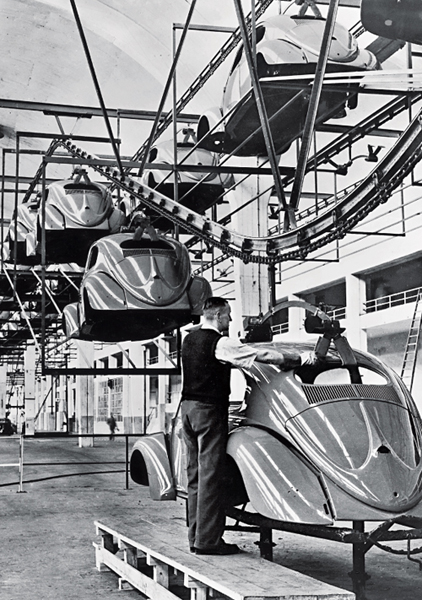The original Volkswagen had the longest production run of any car. Prototypes arrived in Nazi Germany in 1938, though none, in fact, was ever sold to workers saving up their 1,000 Reichsmarks through Hitler’s ‘Strength through Joy’ scheme. Proper production began in 1946 and the final ‘Beetle’ was produced at VW’s Mexican plant in 2003. By that time 21 million had been produced, making it, numerically, the most popular car ever.
So why don’t cars look like Beetles any more? The reason is that the car was born in the imaginations of Adolf Hitler and Ferdinand Porsche (1875–1951) as a uniquely modernistic project ‘to further the motorization of the German people’. As such, it had to express a strong Germanic Modernist aesthetic and the ‘apparent aerodynamic’ form developed by ex-Zeppelin engineer Paul Jaray and the Czech design engineers at Tatra – a make much admired by Hitler, a noted car buff. In fact, notes exist, believed to be by Hitler, from the 1933 meeting with Porsche at Berlin’s Kaiserhof Hotel. Hitler has apparently sketched a generic aerodynamic Tatra/Beetle shape, though whether as a suggestion to Porsche, or as a visualization of what was under discussion, is not clear.
This Jaray/Tatra form, when squashed onto a much smaller utility car, strongly compromised passenger accommodation. Porsche chose a flat ‘boxer’ engine in the rear to indulge the streamline tail and also equipped the car with swing axles – a simple and bad form of independent rear suspension. These features combined could allow dangerous rear-end breakaway on greasy surfaces.
Nevertheless, the Beetle was conceived, all at once, as a single integrated engineering solution with no ‘ad hoc’ solutions or ‘legacy’ components from earlier models. The body structure was superb, rigid, watertight and corrosion-resistant, and the quality of the mechanical parts was unusually high for a popular car. Germany’s preeminence in electromechanical engineering also meant that the electrical equipment (starter motor, ignition equipment and dynamo), often the Achilles’ heel of most budget cars at the time, was excellent, so a Beetle always started on cold, damp mornings. The VW’s success was a triumph of good engineering over questionable chassis design.

The original Beetle.

There is a compelling theatre in car production lines. The VW Wolfsburg plant in 1953. The convex curves and the relief details in every panel gave the Beetle bodywork incredible rigidity.